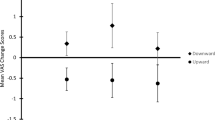Abstract
Both boys and girls are exposed repeatedly to “thin-ideal” images in the media, that is, images of unrealistically thin and attractive women. As yet, however, little research has examined the impact of these images on boys. In the present study we investigated the effect of exposure to televised thin-ideal images on boys' attitudes toward girls. The participants were 354 boys aged 13–15 years, who viewed either 20 commercials that epitomized the thin-ideal for women or 20 commercials that contained no such images. They then rated the importance of 10 characteristics, including slimness and physical attractiveness, in their choice of partner or girlfriend. Appearance schematicity, a trait measure of the extent of investment in appearance as the basis for self-evaluation, was also assessed. It was found that schematicity was positively related to boys' importance ratings of attractiveness, slimness, athletic ability, muscularity, and popularity in a girlfriend. Further, boys who scored medium (but not high or low) on appearance schematicity were influenced by the commercials. These findings suggest that the media may have an indirect impact on girls' body image through influence on boys' expectations and evaluations of girls' appearance.
Similar content being viewed by others
References
Altabe, M., & Thompson, J. K. (1996). Body image: A cognitive self-schema construct? Cognitive Therapy and Research, 20, 171–193.
Barak, A., & Fisher, W. A. (1997). Effects of interactive computer erotica on men's attitudes and behavior toward women: An experimental study. Computers in Human Behavior, 13, 353–369.
Cash, T. F., & Labarge, A. S. (1996). Development of the appearance schemas inventory: A new cognitive body image assessment. Cognitive Therapy and Research, 20, 37–50.
Eagly, A. H., & Chaiken, S. (1993). The psychology of attitudes. New York: Harcourt Brace.
Fong, G. T., & Markus, H. (1982). Self-schemas and judgements about others. Social Cognition, 1, 191–204.
Gerbner, G., Gross, L., Morgan, M., & Signorielli, N. (1994). Growing up with television: The cultivation perspective. In J. Bryant & D. Zillmann (Eds.), Media effects: Advances in theory and research (pp. 17–42). Hillsdale, NJ: Erlbaum.
Goodson, P., McCormick, D., & Evans, A. (2001). Searching for sexually explicit materials on the Internet: An exploratory study of college students' behavior and attitudes. Archives of Sexual Behavior, 30, 101–118.
Groesz, L. M., Levine, M. P., & Murnen, S. K. (2002). The effect of experimental presentation of thin media images on body satisfaction: A meta-analytic review. International Journal of Eating Disorders, 31, 1–16.
Hargreaves, D. A., & Tiggemann, M. (2002). The effect of television commercials on mood and body dissatisfaction: The role of appearance-schema activation. Journal of Social and Clinical Psychology, 21, 287–308.
Harrison, K., & Cantor, J. (1997). The relationship between media consumption and eating disorders. Journal of Communication, 47, 40–67.
Heinberg, L. J., & Thompson, J. K. (1995). Body image and televised images of thinness and attractiveness: A controlled laboratory investigation. Journal of Social and Clinical Psychology, 14, 325–328.
Jansma, L. L., Linz, D. G., Mulac, A., & Imrich, D. J. (1997). Men's interactions with women after viewing sexually explicit films: Does degradation make a difference? Communication Monographs, 64, 1–24.
Jones, D. (2001). Social comparison and body image: Attractiveness comparisons to models and peers among adolescent girls and boys. Sex Roles, 45, 645–664.
Kenrick, D. T., Gutierres, S. E., & Goldberg, L. L. (1989). Influence of popular erotica on judgments of strangers and mates. Journal of Experimental Social Psychology, 25, 159–167.
Lavin, M. A., & Cash, T. F. (2001). Effects of exposure to information about appearance stereotyping and discrimination on women's body images. International Journal of Eating Disorders, 29, 51–58.
Lavine, H., Sweeney, D., & Wagner, S. H. (1999). Depicting women as sex objects in television advertising: Effects on body dissatisfaction. Personality and Social Psychology Bulletin, 25, 1049–1058.
Major, B., Testa, M., & Bylsma, W. (1991). Responses to upward and downward social comparisons: The impact of esteem relevance and perceived control. In J. Suls & T. Wills (Eds.), Social comparison: Contemporary theory and research (pp. 237–260). Hillside, NJ: Erlbaum.
Malamuth, N., Addison, T., & Koss, M. (2000). Pornography and sexual aggression: Are there reliable effects and can we understand them? Annual Review of Sex Research, 11, 26–91.
Markus, H. (1977). Self-schemata and processing information about the self. Journal of Personality and Social Psychology, 35, 63–78.
Markus, H., & Smith, J. (1981). The influence of self-schemata on the perception of others. In N. Cantor & J. F. Kihlstrom (Eds.), Personality, cognition, and social interaction (pp. 233–262). Hillsdale, NJ: Erlbaum.
Markus, H., Smith, J., & Moreland, R. L. (1985). Role of the self-concept in the perception of others. Journal of Personality and Social Psychology, 49, 1494–1512.
Rieves, L., & Cash, T. F. (1996). Social developmental factors on women's body-image attitudes. Journal of Social Behavior and Personality, 11, 63–78.
Tabachnick, B. G., & Fidell, L. S. (2001). Using multivariate statistics (4th ed.). Boston: Allyn and Bacon.
Vitousek, K. B., & Hollon, S. D. (1990). The investigation of schematic content and processing in eating disorders. Cognitive Therapy and Research, 14, 191–214.
Author information
Authors and Affiliations
Corresponding author
Rights and permissions
About this article
Cite this article
Hargreaves, D.A., Tiggemann, M. Female “Thin Ideal” Media Images and Boys' Attitudes Toward Girls. Sex Roles 49, 539–544 (2003). https://doi.org/10.1023/A:1025841008820
Issue Date:
DOI: https://doi.org/10.1023/A:1025841008820




